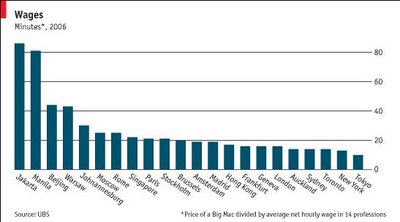Now, your standard trophy wife sitting in the suburbs whose husband makes all the real money while she contemplates how to make her child psychology degree mean something, sits there and after watching "The View" looks around and says, "gosh, I'm pathetic. I haven't done anything with my life. But I must do something, because my 1970's brainwashing tells me to do so."
Of course most of us know that it would be best if she did NOTHING. That she didn't think, that she sat there innoculated from the rest of the world and continued on to eat her bon bons and leave the world be.
But oh no, they have to go on a crusade.
Now, one of these many crusades they decide to go on is fighting for the poorer people of the world. To fight against "slave labor" and to buy coffee from shops that pay a "living wage."
So with little thinking they read in Mother Jones or what have you that the "poor children of country X are paid 43 cents per decade and must eat shrubs to live" and it's all the fault of rich people in the US (of course they'd be paid NOTHING if it weren't for us, so I guess 43 cent is worse than nothing). Regardless, this is why there's this trend to go "organic" and shop at places like Whole Foods amongst the upper classes.
The problem is that when these wage figures are quoted, they are not adjusted for purchasing power. Yes, of course Akbar may make $3/day which in New York City will get you nothing. But in Indonesia it has the equivalent purchasing power of say $25. It's not too unlike
"how much will $10 buy you in Des Moines, Iowa" - Answer 3 heads of cattle, 40 acres of farmland, your own personal F-16 fighter plane and a keg of beer.
versus
"how much will $10 buy you in San Francisco." - parking for 20 minutes.
So to make purchasing power parity understandable, even to the suburbanite trophy wives that could never pass high school algebra, the good men and women at UBS put together this spiffy chart that shows you how long it takes to earn the money to buy a very standard and universal good;
The Big Mac.

I recall being a poo-shoveller making $3.15/hr in the 7th grade, which is about as long as it takes for your average China man to earn the same amount of money for a Big Mac.
"Slave labor" my ass.
7 comments:
Using a Big Mac as the basis of comparison is amusing but proves relatively little. A Big Mac may be close to a staple diet item in the United States but is more of a luxury treat in some other places.
Peter
Iron Rails & Iron Weights
anon,
The Economist magazine (as so loved by our generous host) has produced an annual Big Mac Index for many years now - with the sole purpose of evaluating ppp on as near a common set of terms as possible. The reason for choosing the Big Mac as a common product is indeed it's widespread consumption (very few products in this world can claim to be as worldly), but also the standard set of ingredients which go into making it.
The ingredients tend to be all locally (or regionally) produced (bread, beef, vegetable matter, miscellaneous goo-like substances), and the labor used to transport the materials and ultimately assemble into a Big Mac also tends to be locally provided (as one would imagine).
This makes the Big Mac just about the ideal candidate when looking for a standard ppp subject.
Hi GL and anon,
Yeah, you're right, the Big Mac is certainly a luxury good in most of these countries, but would emphasize the point even more so. Obviously these people are not going to buy a Big Mac as they would a bag of rice (though I remember 1979 when McDonalds was INDEED A LUXURY). As for the methodology's accuracy UBS took 14 different "professions" in those towns.
In my studies I've found the "best" place for figures that are truly adjusted for purchasing power parity is the IMF, and those go to consider a more comprehenseive basket of goods. The Big Mac Index is of course a benchmark figure. Having said that I remember reading somewhere that if you were to have speculated on currencies via the Big Mac Index you would have faired well. But that was a couple years ago.
Indeed, the proffesionals salary in Beijing, ShangHai, Shenzhen of China is about $40-50 k annually. It is already at developed country level. With ppp, they actually live a life style that of $70-100 K uppper middle class in USA. No wonder most those of Chinese middle class believe they had better quality of life than those middle class in West.
A German economic institute has discovered that. Also following link report the income level in shenzhen.
http://www.time.com/time/asia/magazine/article/0,13673,501060821-1226199,00.html
Good article, shows you just how much a run for the money the engineerings and science folk in China are going to give the philosophy majors here in the US.
"Average China man" is an inaccurate statement. Average Beijing, or Shanghai, or some of their other industrial centers, yes. But, looking at most of the country their wages are much lower than that and wouldn't buy a Big Mac in an hour.
I had to sit through a paper presentation yesterday that illustrated this.
Other than that your point is quite valid.
The German institute is Großansicht des Bildes mit der Bildunterschrift, Hewitt Associates.
Reported by Deutsche Welle.
Post a Comment